Among the administrative changes of the Barnett period was the creation of a new office. A Provost was appointed to be in charge of university affairs in the absence of the President. The Vice President for Development was made Vice President for Development, Alumni Affairs, and Public Relations. The office of Vice President for Business and Finance was set up as a concurrent appointment to be held by the Treasurer. The staff of the Dean of Students was enlarged by adding an Assistant Dean of Students for Fraternities, to provide professional leadership in developing policies and standards for fraternity chapter operations.
Colgate’s enrollment, slightly less than 1,500 in 1962, had risen to just over 2,000 in 1968. Tuition, which had been $1,375 in 1962, by 1968 had increased to $2,285. So far as possible students whose financial resources were inadequate to meet costs were assisted by scholarships, work opportunities, and loan funds.
Coeducation became a part of the undergraduate program in 1968. Women were first permitted to study on the graduate level in summer session in 1959 and at the special summer session commencement in 1961 they received their first earned degrees (M.A.). They were admitted to the teaching intern program in 1963 and attended classes during the regular academic year. Accepting the recommendations of a trustee-faculty-administration-alumni committee, the Trustees in 1967 endorsed the principle of coeducation and directed that feasibility studies be made of methods by which it might be adopted. A few months later, however, they decided that a pilot program should be initiated in September, 1968, and three women were admitted as undergraduates. Plans were made for Skidmore College students (approximately 50) to join in the 1969 January Plan on the Colgate campus and for the same number of Colgate students to participate in Skidmore’s January Plan. For the spring term of 1969, Colgate and Vassar College expected to initiate an exchange of students, probably 20-30, on a one-to-one basis. Vassar had already completed similar arrangements with Williams and Trinity Colleges.
Noteworthy features of undergraduate life included the elimination of compulsory chapel. Worship services, normally led by students, were held Wednesday morning with voluntary attendance. In October, 1964, and in March, 1968, students organized and conducted the Creative Arts Festival and the Fortnight of the Arts which afforded





